Blank L., Tarquin A. Engineering Economy (McGraw-Hill Series in Industrial Engineering and Management)
Подождите немного. Документ загружается.

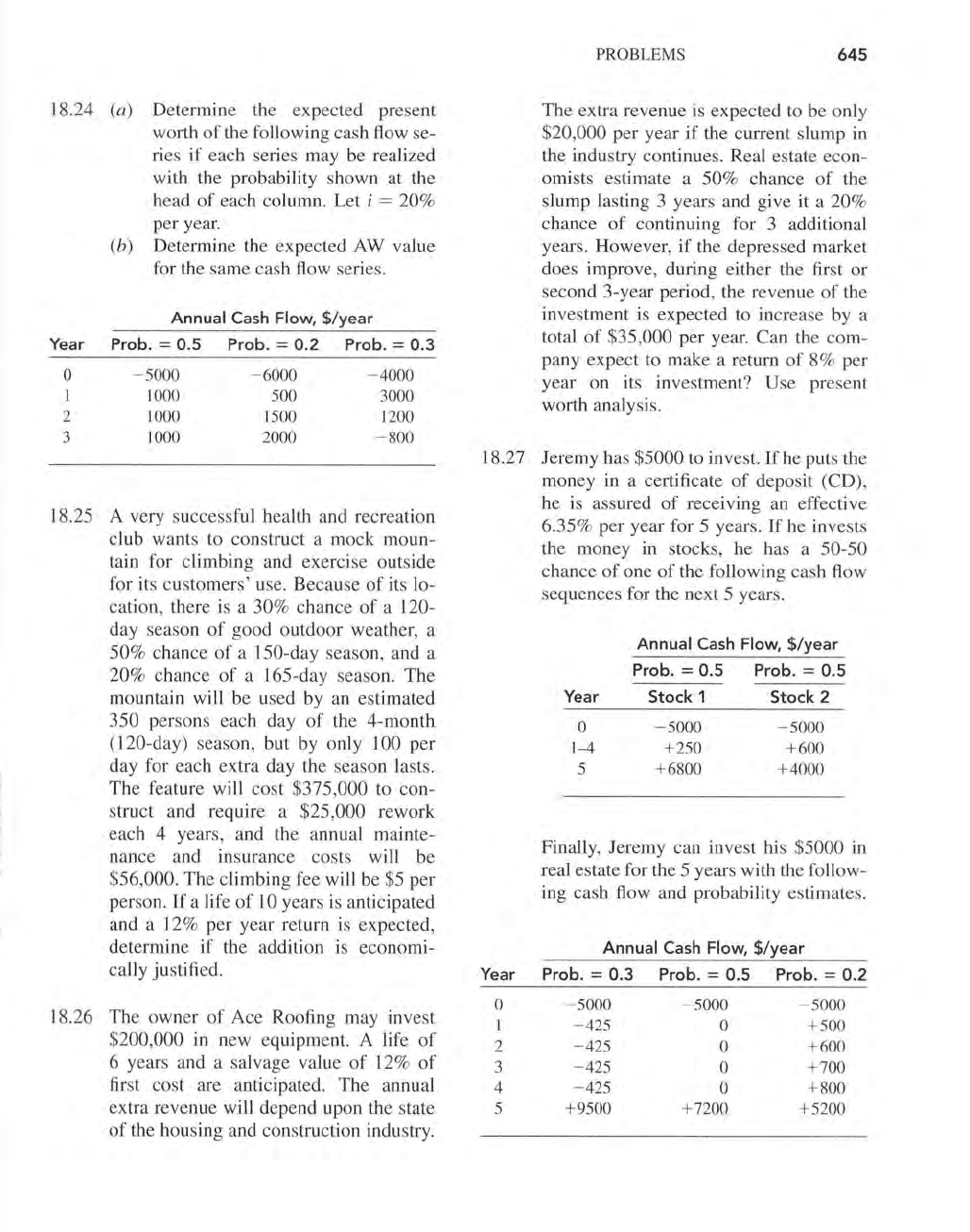
18.24 (a) Determine the expected present
worth
of
the following cash flow se-
ries if each series may be realized
with the probability shown at the
head
of
each column. Let i = 20%
per
year.
(b) Determine the expected
AW
value
for the same cash flow series.
Annual Cash Flow,
$/year
Year Prob. = 0.5 Prob. = 0.2 Prob. = 0.3
a
1
2
3
- 5000
1000
1000
1000
- 6000
500
1500
2000
- 4000
3000
1200
- 800
18.25 A very successful health and recreation
club wants to construct a mock moun-
tain for climbing and exercise outside
for its customers' use. Because
of
its lo-
cation, there is a
30% chance
of
a 120-
day season
of
good outdoor weather, a
50% chance
of
a ISO-day season, and a
20% chance
of
a 165-day season.
The
mountain will be used
by
an
estimated
350 persons each day
of
the 4-month
(l20-day)
season, but
by
only 100
per
day for each extra day the season lasts.
The
feature will cost $375,000 to con-
struct and require a
$25,000 rework
each 4 years, and the annual mainte-
nance and insurance costs will be
$56,000.
The
climbing fee will be $5
per
person.
If
a life
of
10 years
is
anticipated
and a 12%
per
year return is expected,
determine
if
the addition is economi-
cally justified.
18.26 The owner
of
Ace Roofing may invest
$200,000 in new equipment. A life
of
6 years and a salvage value
of
12%
of
first cost are anticipated.
The
annual
extra revenue will depend upon the state
of
the housing and construction industry.
18.27
Year
o
2
3
4
5
PROBLEMS
645
The extra revenue is expected to be only
$20,000 per year
if
the current slump
in
the industry continues. Real estate econ-
omists estimate a
50% chance
of
the
slump lasting 3 years and give it a
20%
chance
of
continuing for 3 additional
years. However,
if
the depressed market
does improve, during either the first or
second 3-year period, the revenue
of
the
investment is expected to increase by a
total
of
$35,000 per year. Can the com-
pany expect to make a return
of
8% per
year on its investment?
Use present
worth analysis.
Jeremy has
$5000 to invest.
If
he puts the
money in a certificate
of
deposit (CD),
he
is
assured
of
receiving an effective
6.35% per year for 5 years.
If
he invests
the money in stocks, he has a
50-50
chance
of
one
of
the following cash flow
sequences for the next 5 years.
Year
o
1-4
5
Annual Cash Flow,
$/year
Prob. = 0.5 Prob. = 0.5
Stock
1
- 5000
+250
+ 6800
Stock
2
- 5000
+ 600
+4000
Finally, Jeremy can invest his $5000
in
real estate for the 5 years with the follow-
ing cash flow and probability estimates.
Annual Cash Flow,
$/year
Prob. = 0.3 Prob. = 0.5 Prob. = 0.2
- 5000 - 5000
- 5000
- 425
a
+ 500
- 425
a + 600
- 425
a + 700
- 425
a + 800
+ 9500 +7200 + 5200
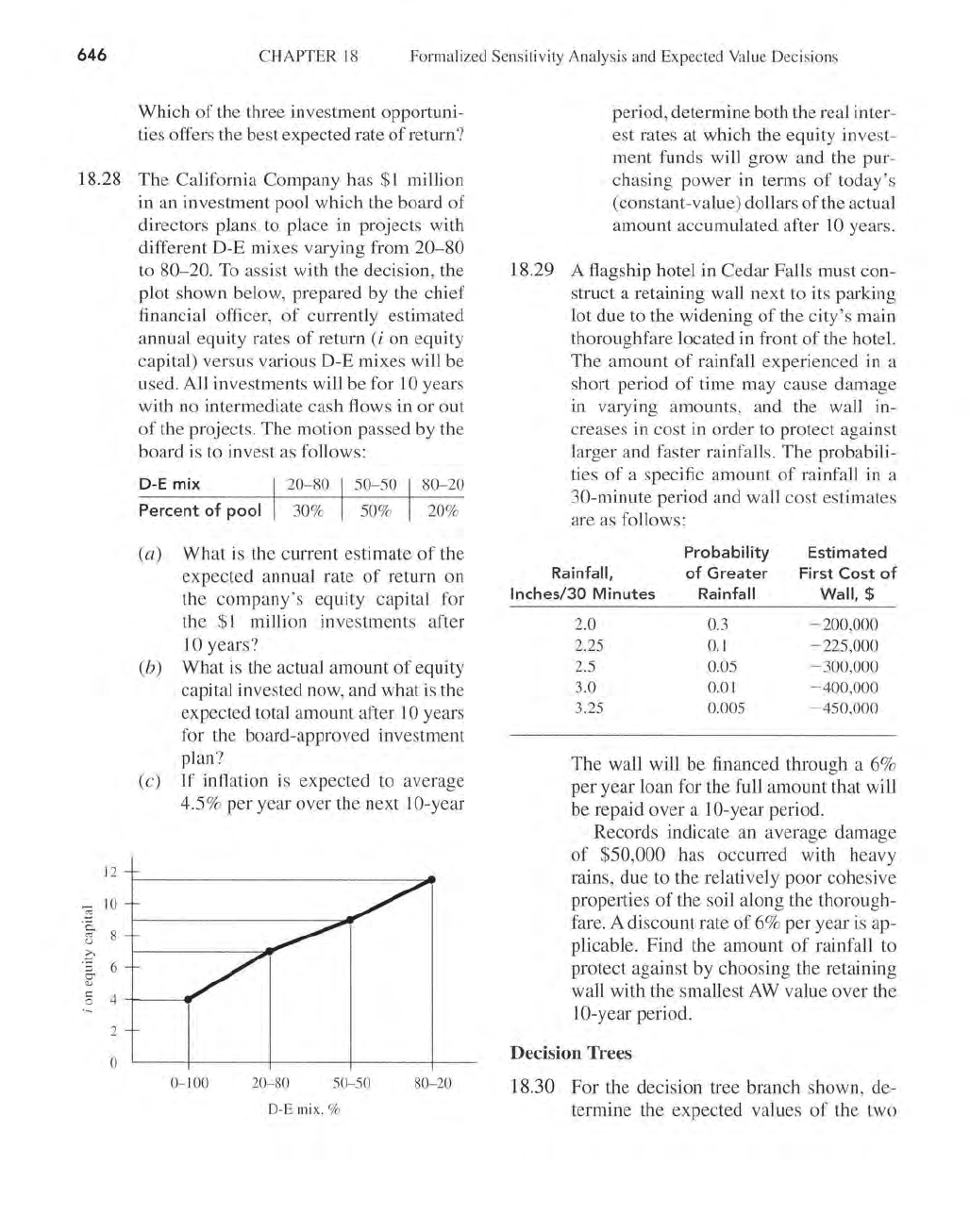
646
18
.28
12
'§
10
"0..
8
'"
u
.q
6
g,
OJ
g
4
2
0
CHAPTER
18
Formalized Sensitivi
ty
Analysis and Expected Value Decisions
Which
of
the three investment opportuni-
ties offers the best expected rate
of
return?
The
California Company has
$1
million
in an investment pool which the board
of
directors plans to place in projects with
different
D-E
mixes varying from
20-80
to
80-20
. To assist with the decision, the
plot shown below, prepared by the
chief
financial officer,
of
currently estimated
annual equity rates
of
return
(i
on
equity
capital) versus various
D-E
mixes will be
used.
All investments will be for 10 years
with no intermediate cash flows in
or
out
of
the projects. The motion passed by the
board is to invest as follows:
D-E
m
ix
80-20
Percent
of
pool
20%
(a)
What
is
the current estimate
of
the
expected annual rate
of
return on
the
company's
equity capital for
the
$1
million investments after
10
years?
(b)
What is the actual amount
of
equity
capital invested now, and what is the
expected total amount after
10 years
for the board-approved investment
plan?
(c) If inflation
is
expected to average
4.5% per year over the next lO-year
0- 1
00
20-80
50
-
50
80
-
20
D
-E
mix, %
18.29
period, determine both the real inter-
est rates at which the equity invest-
ment funds will grow and the pur-
chasing
power
in terms
of
today's
(constant-value) dollars
of
the actual
amount accumulated after
10
years.
A flagship hotel in Cedar Falls must con-
struct a retaining wall next to its parking
lot due to the widening
of
the city's main
thoroughfare located
in
front
of
the hotel.
The
amount
of
rainfall experienced
in
a
short period
of
time may cause damage
in varying amounts, and the wall in-
creases in cost
in
order to protect against
larger and faster rainfalls.
The
probabili-
ties
of
a specific amount
of
rainfall in a
30-minute period and wall cost estimates
are as follows:
Probability
Estimated
Rainfall,
of
Greater
First
Cost
of
Inches/3D Minutes Rainfall Wa
ll,
$
2.0 0.3 - 200,000
2.25
0.1
- 225,000
2.5 0.05 - 300,000
3.0
0.01
- 400,000
3.25
0.005 - 450.000
The wall will be financed through a 6%
per year loan for the full amount that will
be repaid over a ] O-year period.
Records indicate an average damage
of
$50,000 has occurred with heavy
rains, due to the relatively poor cohesive
properties
of
the soil along the thorough-
fare. A discount rate
of
6% per year is ap-
plicable. Find the amount
of
rainfall to
protect against by choosing the retaining
wall with the smallest A W value over the
J O-year period.
Decision
Trees
18.30
For
the decision tree branch shown, de-
termine the expected values
of
the two
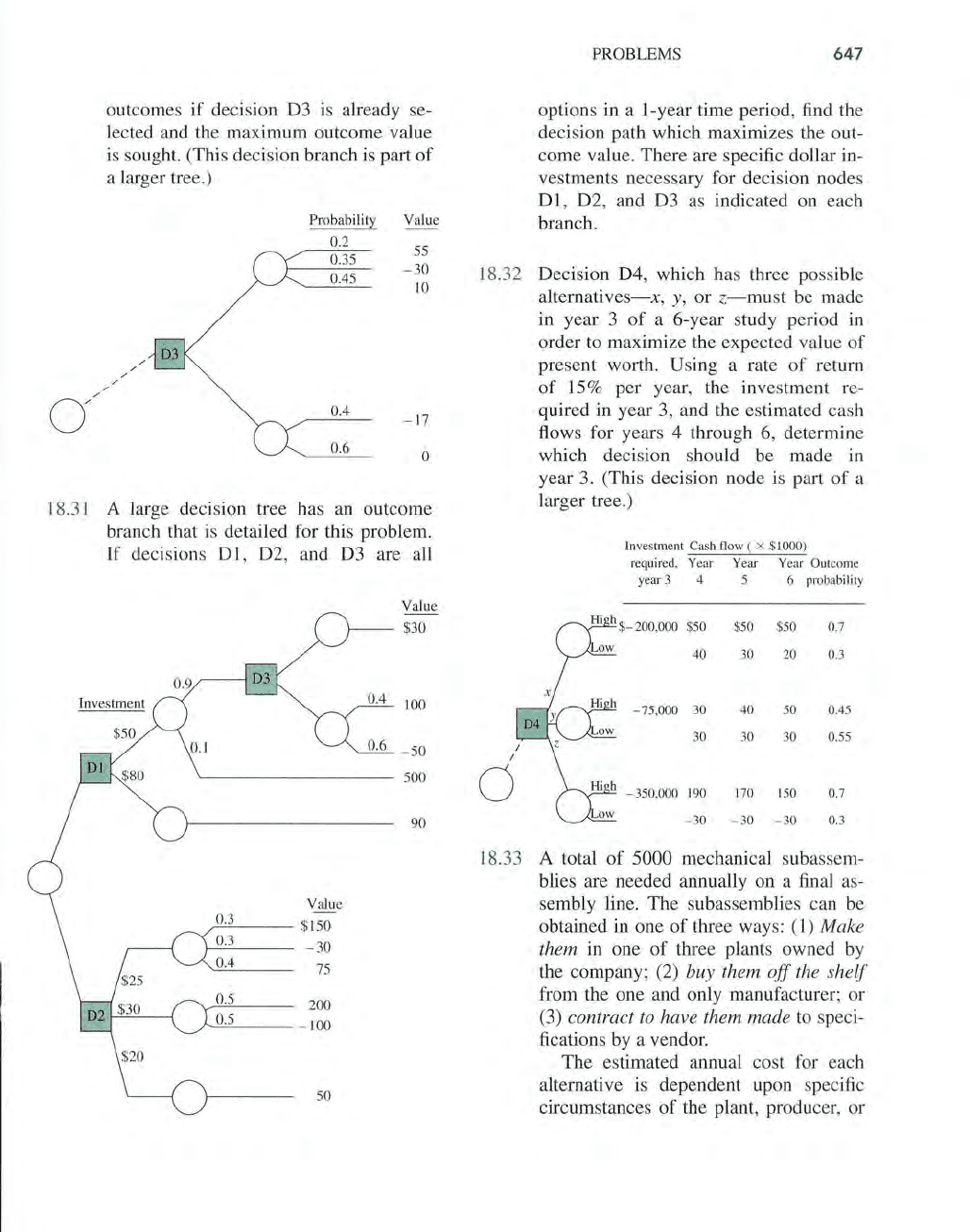
outcomes if decision D3 is already se-
lected and the maximum outcome value
is sought. (This decision branch is part
of
a larger tree.)
Probability Value
0.2
55
0.
35
0.45
- 30
10
0.4
-17
0.6
o
18
.
31
A large decision tree has an outcome
branch that is detailed for this problem.
If
decisions
DI
, D2, and D3 are all
Value
PROBLEMS
647
options in a I-year time period, find the
decision path which maximizes the out-
come value. There are specific dollar in-
vestments necessary for decision nodes
DI,
D2, and D3
as
indicated on each
branch.
18.32 Decision D4, which has three possible
alternatives-x,
y, or
z-must
be made
in year 3
of
a 6-year study period in
order to maximize the expected value
of
present worth. Using a rate
of
return
of
15% per year, the investment re-
quired in year 3, and the estimated cash
flows for years 4 through
6,
determine
which decision should be made
in
year 3. (This decision node is part
of
a
larger tree.)
Investment Cash flow ( X $1000)
required, Year Year Year Outcome
year 3 4 6 probability
$30 $50 $50 0.7
0.4
100
0.6 - 50
500
90
Value
0.3
$150
0.3
- 30
0.4
75
0.5
200
0.5
-
100
50
/
/
0
40 30 20 0
.3
- 75,000 30
30
-350,000
J 90
- 30
40
30
170
- 30
50
30
150
- 30
0.45
0.55
0.7
0.3
18.33 A total
of
5000 mechanical subassem-
blies are needed annually on a final as-
sembly line. The subassemblies can be
obtained in one
of
three ways: (1) Make
them
in one
of
three plants owned
by
the company; (2) buy them
off
the
shelf
from the one and only manufacturer; or
(3)
contract to have them made
to
speci-
fications by a vendor.
The estimated annual cost for each
alternative is dependent upon specific
circumstances
of
the plant, producer, or
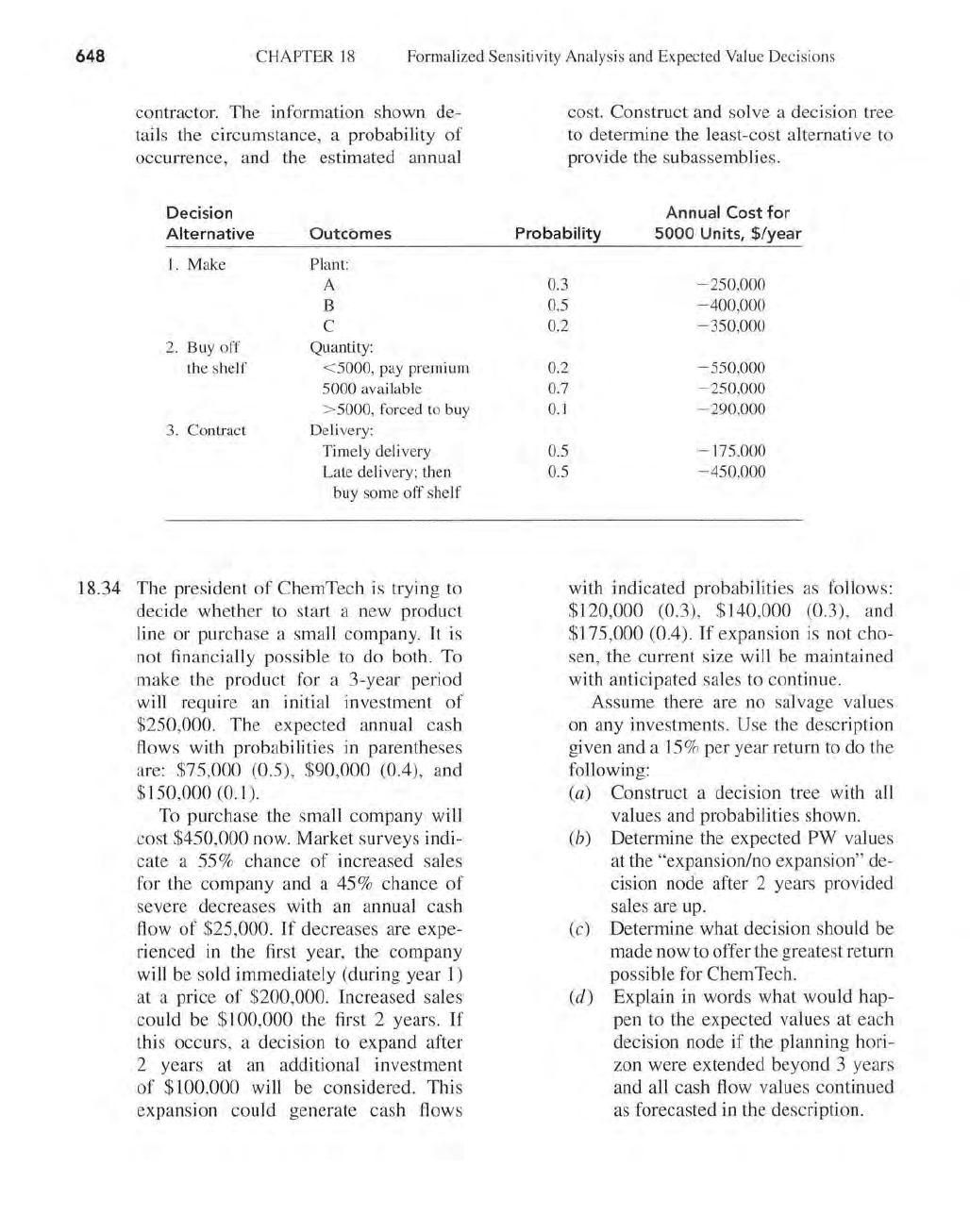
648
CHAPTER
18
Forma
lized Sensitivity Analysis and Expected Value Decisions
contractor. The information shown de-
tails the circumstance, a probability
of
occurrence, and the estimated annual
Decision
Al
ternat
i
ve
I.
Make
2.
Buy
off
the s
helf
3. Contract
Outcomes
Plant:
A
B
C
Quantity:
< 5000, pay premium
5000 available
> 5000, forced to buy
Delivery:
Timely delivery
Late delivery; then
buy some off shelf
18.34 The president
of
ChemTech
is
trying to
decide whether to start a new product
line or purchase a small company.
It
is
not financially possible to do both. To
make the product for a 3-year period
will require an initial investment
of
$250,000. The expected annual cash
flows with probabilities in parentheses
are:
$75,000 (0.5), $90,000 (0.4), and
$150,000 (0.1).
To purchase the small company will
cost
$450,000 now. Market surveys indi-
cate a 55% chance
of
increased sales
for the company and a 45% chance
of
severe decreases with an annual cash
flow
of
$25,000.
If
decreases are expe-
rienced in the first year, the company
will be sold immediately (during
ye~r
1)
at a price
of
$200,000. Increased sales
cou
Id
be $100,000 the first 2 years.
If
this occurs, a decision to expand after
2 years at an additional investment
of
$100,000 will be considered. This
expansion could generate cash flows
cost. Construct and solve a decision tree
to determine the least-cost alternative
to
provide the subassemblies.
Annual
Cost
for
P
robabil
i
ty
5000
Units,
$/year
0.3
0.5
0.2
0.2
0.7
0.1
0.5
0.5
- 250,000
- 400,000
- 350,000
- 550,000
- 250,000
-290,000
-
175
,000
- 450,000
with indicated probabilities as follows:
$120,000 (0.3), $140,000 (0.3), and
$175,000 (0.4).
If
expansion is not cho-
sen, the current size will be maintained
with anticipated sales to continue.
Assume there are no salvage values
on any investments.
Use the description
given and a 15% per year return to do the
following:
(a) Construct a decision tree with all
values and probabilities shown.
(b) Determine the expected PW values
at the
"expansion/no expansion" de-
cision node after 2 years provided
sales are up.
(c) Determine what decision should be
made now to offer the greatest return
possible for ChemTech.
(d)
Explain in words what would hap-
pen to the expected values at each
decision node
if
the planning hori-
zon were extended beyond 3 years
and all cash flow values continued
as forecasted in the description.

CASE STUDY
649
EXTENDED EXERCISE
CASE STUDY
LOOKING
AT
ALTERNATIVES FROM DIFFERENT ANGLES
Berkshire Controllers usually finances its engineering projects with a combina-
tion
of
debt and equity capital. The resulting
MARR
ranges from a low
of
8% per
year,
if
business is slow, to a high
of
15
% per year. Normally, a 10% per year
return
is
expected. Also the life estimates for assets tend to go down about 20%
from normal in a vigorous business environment, and up about 10% in a reced-
ing economy. The following estimates are the most likely values for two plans
currently being evaluated.
Use these data and a spreadsheet to answer the ques-
tions below.
Plan B
Plan A
Asset
1
Asset
2
Fi
rst cost, $
- 10,000
-30,000
- 5000
AOC, $ per year
-500
- 100 - 200
Salvage value, $
1000 5000
- 200
Estimated life, years 40 40 20
Questions
1.
Are the PW values for plans A and B sensitive to changes in the MARR?
2.
Are the PW values sensitive to varying life estimates?
3.
Plot the results above on separate charts for MARR and life estimates.
4. Is the breakeven point for the first cost
of
plan A sensitive to the changes in
MARR as business goes from vigorous to receding?
SENSITIVITY ANALYSIS
OF
PUBLIC SECTOR
PROJECTS- WATER SUPPLY PLANS
Introduction
One
of
the most basic services provided
by
municipal
governments
is
th
e delivery
of
a safe, reUable water
suppl
y.
As cities grow and extend their boundaries
to
outlying areas, they often inherit water systems that
were not constructed according to city codes. The up-
grading
of
these systems
is
sometimes more expensive
than installing one correctly
in
the first place.
To
avoid
these problems, city officials sometimes install water
systems beyond the existing city limits in anticipation
of
fUnlre
growth. This case snldy was extracted from
such a countywide water and waste-water manage-
ment plan and
is
limited to only some
of
the water sup-
ply alternatives.
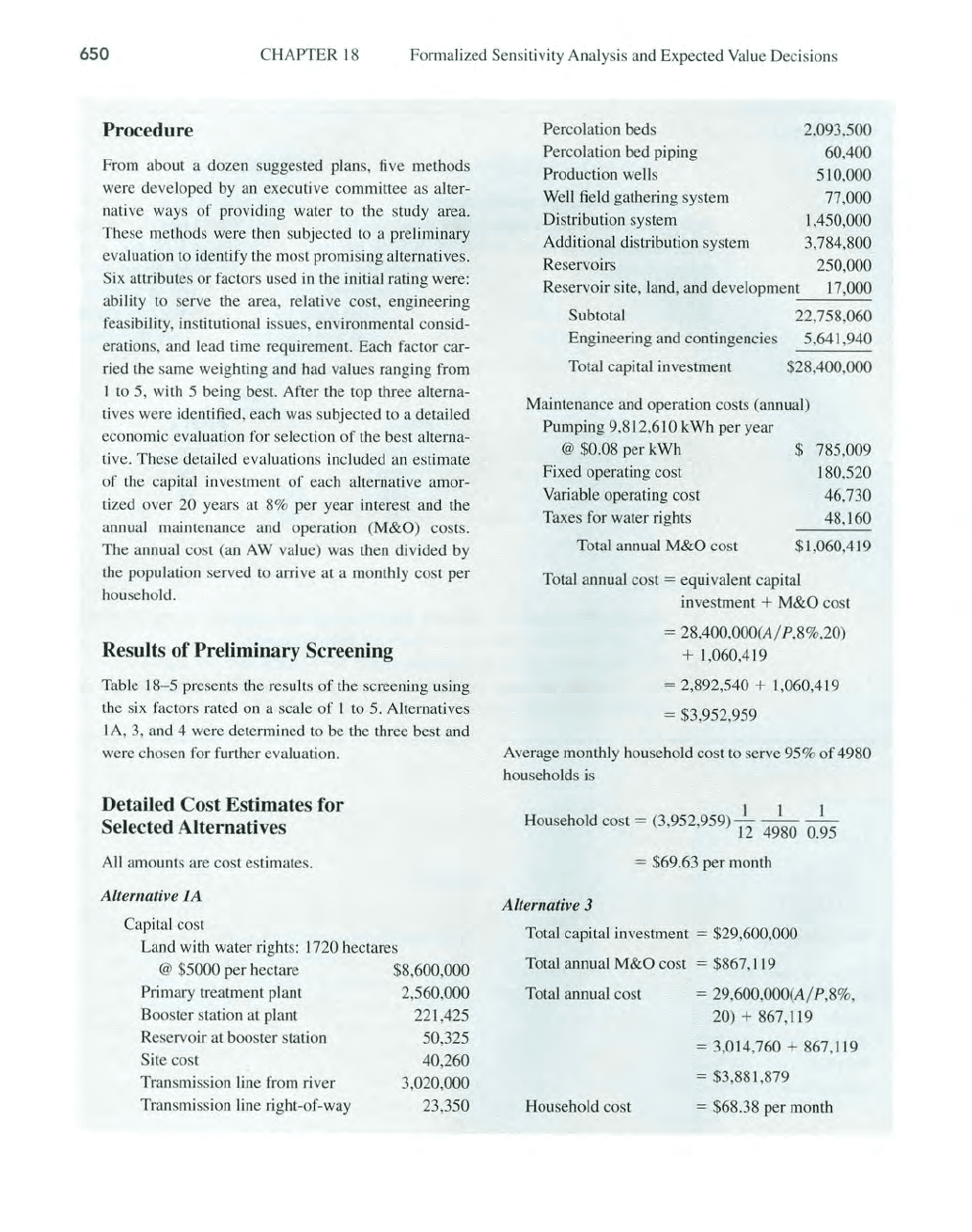
650
CHAPTER 18
Formalized Sensitivity Analysis and Expected Value Decisions
Procedure
From about a dozen suggested plans, five methods
were developed by an executive committee as alter-
native ways
of
providing water
to
the study area.
These methods were then subjected to a preliminary
evaluation
to
identify the most promising alternatives.
Six attributes or factors used in the initial rating were:
ability to serve the area, relative cost, engineering
feasibility,
in
stitutional issues, environmental consid-
eration , and lead time requirement. Each factor car-
ried the same weighting and had values ranging from
I
to
5, with 5 be
in
g best. After the top three alterna-
tives were identified, each was subjected to a detailed
economic
eva
luation for selection
of
the best alterna-
tive. These detailed eva
lu
ations included an estimate
of
the capital investment
of
each alternative amor-
tized over
20 years
at
8% per year interest and the
annual maintenance and operation (M&O) costs.
The annual cost (an
AW
va
lu
e) was then divided by
the population served to arrive at a monthly cost per
household.
Results
of
Preliminary Screening
Table 1
8-5
presents the results
of
the screening using
the six factors rated on a scale
of
I to
5.
Alternatives
I A, 3, a
nd
4 were determined to be the three best and
were chosen for further eva
lu
ation.
Detailed Cost Estimates for
Selected Alternatives
All amounts are cost estimates.
Alternative
lA
Capital cost
Land with water rights:
1720 hectares
@ $5000 per hectare $8,600,000
Primary
treatment plant
Booster station at plant
Reservoir at booster station
Site cost
Transmission
line from river
Transmission line right-of-way
2,560,000
221,425
50
,325
40,260
3,020,000
23,350
Percolation beds
Percolation bed piping
Production wells
Well field gathering system
Distribution system
Additional distribution system
Reservoirs
Reservoir site, land, and development
2,093,500
60,400
510,000
77,000
1,450,000
3,784,800
250,000
17
,000
Subtotal 22,758,060
Engineering and contingencies 5,641,940
Total capital investment
$28,400,000
Maintenance and operation costs (annual)
Pumping 9,812,610 kWh per year
@ $0.08 per
kWh
$ 785,009
180,520
46,730
48,160
Fixed operating cost
Variable operating cost
Taxes for water rights
Total annual
M&O
cost
$1,060,419
Total annual cost = equivalent capital
investment
+
M&O
cost
= 28,400,000(Aj P,8%,20)
+ 1,060,419
= 2,892,540 + 1,060,419
= $3,952,959
Average monthly household cost to serve 95%
of
4980
households is
1 1 1
Household cost = (3,952,959)
12
4980 0.95
= $69.63 per month
Alternative 3
Total capital investment = $29,600,000
Total annual
M&O
cost = $867,
119
Total annual cost
Household cost
= 29,600,000(Aj P,8%,
20) + 867,119
= 3,014,
760
+ 867,
11
9
= $3,881,879
= $68.38 per month

0-
<.n
-'
Alternative
l A
3
4
8
12
Descri
pt
ion
Receive city
wat
er
and
recharge
wells
Jo
in
t city
and county
plant
Coun
ty
treatment
plant
Desalt
gro
un
dwater
Develop
mi
litary
water
Ability
to
Supply
Area
5
5
4
5
Factors
Relative Engineer
in
g Institutional Environmental
Lead-Time
Cost
Feasibili
ty
Issues
Considerations Requirement
Total
4 3 4 5 3
24
4
4
3
4
3
23
4
3
3
4
3
21
2 3
4
12
5
4
3
19
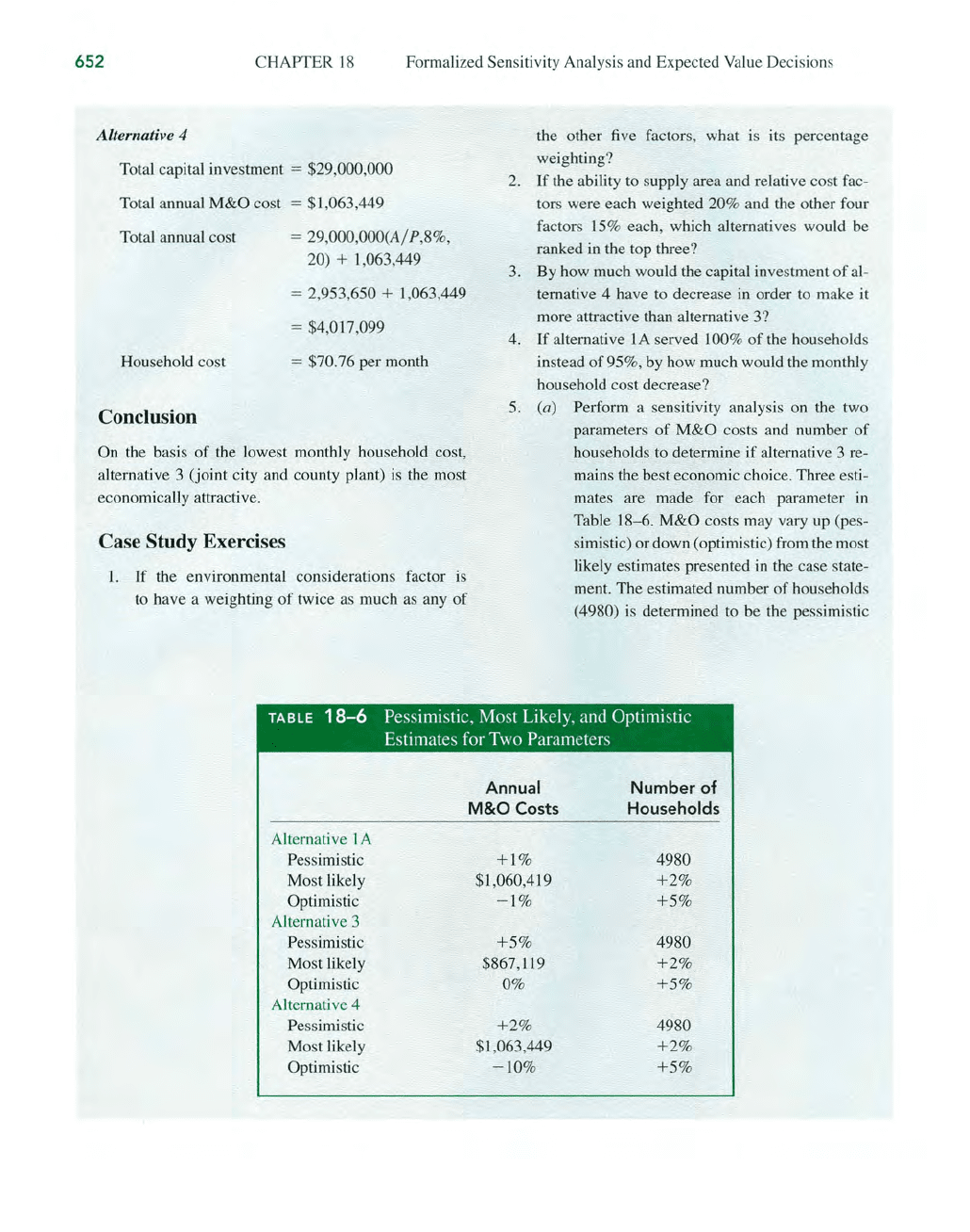
652
CHAPTER 18 Formalized Sensitivity Analysis and Expected Value Decisions
Alternative 4
Total capital investment = $29,000,000
Total annual M&O cost = $ 1,063,449
Total annual cost
Household cost
Conclusion
= 29,000,000(A/ P,8%,
20) + 1,063,449
= 2,953,650 + 1,063,449
= $4,017,099
= $70.76 per month
On the basis
of
the lowest monthly household cost,
alternative 3 (joint city and county plant)
is
the most
economically attractive.
Case Study Exercises
1.
If
the environmental considerations factor is
to have a weighting
of
twice as much as any
of
the other five factors, what is its percentage
weighting?
2.
If
the ability to supply area and relative cost fac-
tors were each weighted
20% and the other four
factors
15
% each, which alterna
ti
ves would be
ranked
in
the top three?
3. By how much would the capital investme
nt
of al-
ternative 4 have to decrease
in
order to make it
more attractive than alternative 3?
4.
If
alternative
lA
served 100%
of
the households
instead
of95
%, by how much would the monthly
household cost decrease?
5. (a) Perform a sensitivity analysis on the two
parameters
of
M&O costs and number
of
households to determine if alternative 3 re-
mains the best economic choice. Three esti-
mates are made for each parameter
in
Table
18
-
6.
M&O costs may vary
up
(pes-
simistic) or down (optimistic) from the most
likely estimates presented
in
the case state-
ment. The estimated number
of
households
(4980)
is
determined to be the pessimistic
TABLE
18-6
Pessimistic, Most Likely. and Optimistic
Estimates for Two Parameters
Annual Number
of
M&O
Costs Households
Alternative 1 A
Pessimistic
+1
% 4980
Most likely $1,060,419
+2%
Optimistic
-1%
+5%
Alternative 3
Pessimistic
+5%
4980
Most likely $867,119
+2%
Optimistic 0%
+5%
Alternati ve 4
Pessimistic
+2
% 4980
Most likely
$1
,063,449
+2
%
Optimistic
-)0
%
+5
%

estimate. Growth
of
2%
up
to 5%
(o
pti-
mi
s
ti
c) will tend
to
lower the monthly cost
per household.
(b) Cons.
id
er the monthly cost per household for
alternative 4, the optimistic estimate. The
number
of
households is 5% above 4980,
CASE STUDY
653
or 5230. What is the number
of
households
that would have
to
be available in order
for this option only
to
have exactly the
same monthly household cost
as
that for
alternative 3 at the optimistic estimate
of
5230 households?
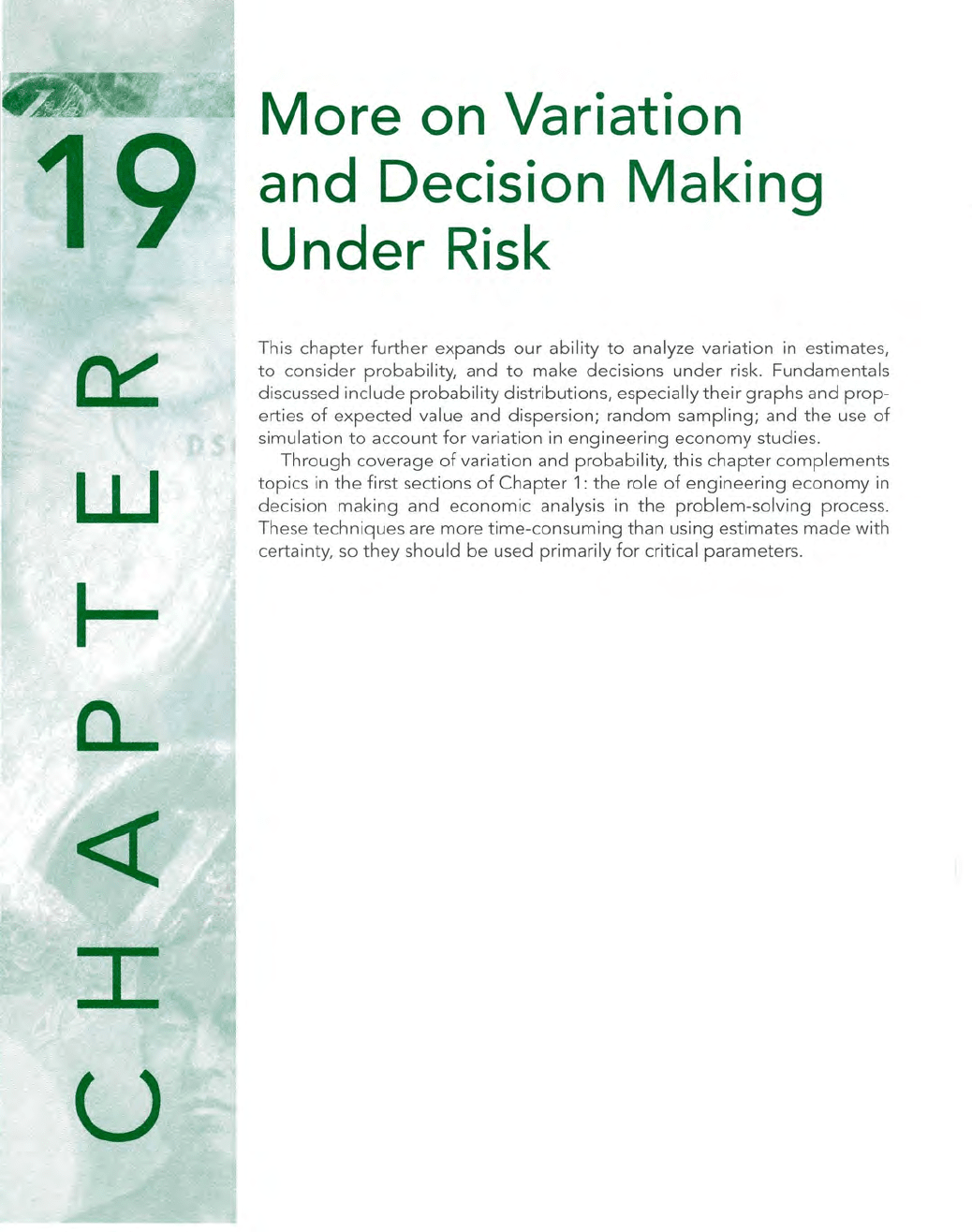
UJ
u
More
on Variation
and Decision Making
Under
Risk
This
chapter
further
expands
our
ability
to
analyze variation in estimates,
to
consider
probability,
and
to
make
decisions
under
risk.
Fundamentals
discussed
include
probability
distributions,
especially
their
graphs
and
prop-
erties
of
expected
value and
dispersion;
random
sampling;
and
the
use
of
simulation
to
account
for
variation
in
engineering
economy
studies.
Through
coverage
of
variation and
probability,
this
chapter
complements
topics
in
the
first sections
of
Chapter
1:
the
role
of
engineering
economy
in
decision
making
and
economic
analysis in
the
problem-solving
process.
These
techniques
are
more
time-consuming
than using estimates
made
with
certainty, so
they
should
be
used
primarily
for
critical parameters.
